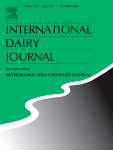Ver ítem
- xmlui.general.dspace_homeCentros Regionales y EEAsCentro Regional Santa FeEEA RafaelaArtículos científicosxmlui.ArtifactBrowser.ItemViewer.trail
- Inicio
- Centros Regionales y EEAs
- Centro Regional Santa Fe
- EEA Rafaela
- Artículos científicos
- Ver ítem
Increase of milk heat stability by addition of casein glycomacropeptide
Resumen
The effect of caseinglycomacropeptide (CMP) addition on the heat stability and physicochemical characteristics of milk was studied. The heat coagulation time (HCT) of milk samples with different CMP concentrations added were analysed and was observed that HCT increased when CMP was added in concentrations between 0.4 and 1.25% (w/w). Therefore, a more detailed physicochemical study was carried out in milks with CMP concentrations of 0.4, 0.6 and 0.8%
[ver mas...]
The effect of caseinglycomacropeptide (CMP) addition on the heat stability and physicochemical characteristics of milk was studied. The heat coagulation time (HCT) of milk samples with different CMP concentrations added were analysed and was observed that HCT increased when CMP was added in concentrations between 0.4 and 1.25% (w/w). Therefore, a more detailed physicochemical study was carried out in milks with CMP concentrations of 0.4, 0.6 and 0.8% (w/w). Also, the effect of two heat treatments to milk with CMP addition, applying conditions similar to UHT and in container sterilisation, was monitored. Two opposing effects were observed. On the one hand, CMP bound calcium conferring heat stability and, on the other, increased total electrical conductivity decreased the pH, slightly destabilising serum proteins and, hence, inducing colloidal instability. Therefore, there is a concentration range in which this peptide may act as heat stabiliser and as a nutritional additive in milk.
[Cerrar]

Autor
Acosta, Nadia Belen;
Costabel, Luciana Maria;
Campos, Sonia;
Cuatrin, Alejandra;
Olivares, Maria Laura;
Fuente
International Dairy Journal 139 : 105559 (April 2023)
Fecha
2023-04
Editorial
Elsevier
ISSN
0958-6946
Documentos Relacionados
Formato
pdf
Tipo de documento
artículo
Proyectos
(ver más)
INTA/2019-PD-E7-I152-001/2019-PD-E7-I152-001/AR./Alimentos nutracéuticos, funcionales o para regímenes especiales.
Palabras Claves
Derechos de acceso
Embargado
 Excepto donde se diga explicitamente, este item se publica bajo la siguiente descripción: Creative Commons Attribution-NonCommercial-ShareAlike 2.5 Unported (CC BY-NC-SA 2.5)
Excepto donde se diga explicitamente, este item se publica bajo la siguiente descripción: Creative Commons Attribution-NonCommercial-ShareAlike 2.5 Unported (CC BY-NC-SA 2.5)

